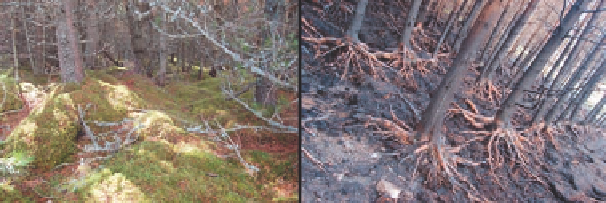Geology Reference
In-Depth Information
erosion, and loss at deeper layers leads to potential structural collapse. Overhangs, holes in the ground, and
pan-shaped voids are commonly produced and can lead to local subsidence. Smoldering fires lead to enhanced
heat transfer to the soil for much longer durations, that is, temperatures above 400°C for residence times
longer than one hour (Rein et al., 2008). This induces sterilization and chemical changes in the surrounding
materials.
Smoldering Wildfires
S
moldering fires of the forest floor are in general better documented than coal fires, and much can be learnt from
reviewing this information. Forest fuels prone to smolder during wildfires can be divided in two categories, thick
fuels and organic soils. Natural thick fuels are stumps, snags, downed logs, large branches, and roots. Organic
soils are humus, duff, and peat. Smoldering does not have the visual impact of the forest flaming fires but is
nonetheless an important factor in wildfires and in the subsequent damage to the forest. By propagating below
the surface, smoldering fires offer the means for flaming combustion to reestablish during wildfires in unex-
pected locations (e.g., across a fire break) and at unexpected times (e.g., long after burn out of the flaming front).
These fires represent a large contributor to biomass consumption and a significant source of combustion
emissions to the atmosphere.
The largest peat fires registered to date took place in Indonesia during the El Niño dry season of 1997 and lasted for
several months, destroying over 2.44 million ha of peat (Page et al., 2002). The smoky haze covered large parts of
Southeast Asia for weeks, disrupting shipping and aviation and causing large economic losses, long-term damage
to the environment, and health-care problems. It has been estimated that the 1997 Indonesia fires alone released
between 0.8 and 2.6 Gton of carbon emissions into the atmosphere, equivalent to 13
-
40% of the global fossil fuel
emissions for that year (Page et al., 2002).
A recent case of a smoldering fire causing damage to the landscape and the ecosystem is a wildfire that
occurred in a 40-year-old, 15 ha plantation of lodge pole pines at Rothiemurchus, near Aviemore, Scotland,
during July 2006 (Rein et al., 2008). The flaming fire was extinguished by the fire service within 3 days, but
the peat underneath the forest continued to burn for more than 40 days despite the occasional rains (Figure
17.1.5). To stop the spread, the fire service dug a firebreak trench 5m wide and 0.5
2m deep at the
perimeter of the burning areas to remove the peat and expose the mineral soil. Figure 17.1.5 shows
photographs of adjacent forest stands after the fire. While the flaming fire scorched the trees up to 1m
from the floor and consumed some of the grass, the smoldering fire burned the peat up to depths of 0.5
-
-
1m
removing large quantities of the soil.
Figure 17.1.5. Photographs illustrating adjacent forest stands in the July 2006 Rothiemurchus peat fire, Scotland,
UK (Rein et al., 2008). In this forest, the peat is 0.5
2 m deep. Burning involved flames for 3 days and smoldering
for 6 weeks. Stand (left) not affected by the fire, showing trees growing in a peat layer covered with grass. Stand
(right) of tree trunks charred by flames. After the grass burned off, smoldering fire burned off about 0.5m of peat,
leaving roots exposed. The roots might extend into a soil horizon beneath the peat. Regardless, the entire stand fell
over about three weeks later, when winds picked up. The horizontal field of view in each photo is about 6 m. Photos
by Guillermo Rein, 2006
-
.



